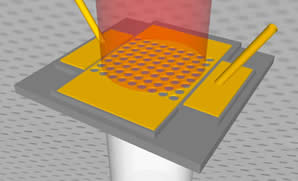Dan Wasserman
| Department of Physics and Applied Physics
| PROFILE | CURRICULUM VITAE | TEACHING | RESEARCH OVERVIEW | PROJECTS | RECENT PUBLICATIONS | OUTREACH | GROUP MEMBERS | CONTACT | HOME |

Former Group Members:
Zachariah Johnson, grauated with B.S. in Physics, May 2010.
Cynthia Mitchell, summer 2009
Karen Freitas, Master's Project
Chris Reidy, Undergraduate, now Ph.D. student at OregonState University
Melissa Spencer, Undergraduate, now at MIT Lincoln Labs
About the UML Mid-IR Photonics Lab:
The mid-infrared spectral range (3-30mm) is of siginificant interest for fundamental research into optics, quantum mechanics, light-matter interaction, and metamaterials. One of the many reasons the mid-IR is such an exciting field to work in is that this ongoing fundamental research has rapidly and effectively found its way to numerous technological applications, in fields as diverse as medicine (i.e. breath analysis), environmental engineering (i.e. industrial emissions monitoring), defense (i.e. explosives and chemical agent detection, thermal imaging, countermeasures), and communications (i.e. free-space wireless), to name only a few.
Much of the motivation for our work in the mid-IR is a result of the numerous species which have strong optical absorption peaks in this spectral range. Because so many species (Methane, CO2, CO, Ammonia, etc) have strong and narrow absorption lines in the mid-IR, the mid-IR is often referred to as the "fingerprint" region of the optical spectrum, as each species has a unique spectral fingerprint in this range.
The remarkable growth in mid-IR photonics has been fueled by the extraordinarily rapid development of a new type of semiconductor laser, known as the Quantum Cascade Laser (QCL). The QCL utilizes intersubband transitions between quantum states in complex semiconductor heterostructure devices. Because the properties of these emitters are determined by the quantum design of the QC heterostructure, QC laser designers have remarkable control over the optical and electronic properties of these devices. Quantum Cascade lasers have been designed for wavelengths across the entire mid-IR spectral region, and a new class of QCLs, designed to operate in the THz, has also recently been developed.
Our Work
Much of the work in the UML MIRPL Lab is focused on developing the next generation mid-IR optical infrastructure designed to integrate with, and leverage, the remarkable power and flexibility of the QCL. Much of our work, in this regard, has focused on the development of metal optics (sometimes refered to as Plasmonics) for mid-IR frequencies. We are looking at unique metal/dielectric structures designed to steer mid-IR laser beams, control the interaction of mid-IR light with trace gases, and steer mid-IR surface waves on-chip, for optical circuitry. We are interested not just in passive optical elements, but more specifically, in developing devices where we are able to control plasmonic resonances with applied voltages, optical signals, or other dielectric tuning mechanisms. In doing so, we have demonstrated a new class of optical devices based on electrical tuning of surface plasmon resonances.
We are also working to develop a new class of mid-IR sources based on intersubband optical transitions in semiconductor quantum dots, devices which may allow for higher wall-plug efficiency, in certain applications, than standard QCLs, as well as allowing for the development of vertical cavity surface emitting mid-IR lasers.
These projects involve designing, growing, fabricating and characterizing novel Quantum Cascade Lasers or other mid-IR optoelectronic devices, making full use of the state-of-the-art growth and processing facilities at the UML Photonics Center.
The Lab
In addition to the resources available in the UML Photonics Center (3 Molecular Beam Epitaxy (MBE) machines, full semiconductor processing facility with optical lithography, metal deposition, wet/dry etching, and mounting and packaging capabilities), the UML MIPh lab features two Bruker FTIR spectrometers (Vertex 70 and Vertex 80) with step-scan measurement capabilities and external input and output ports, a mid-IR microscope, a JobinYvon CCD spectrometer for visible/near-IR photoluminescence and electroluminescence measurements, a thermal imaging camera, a commercially-available tunable extrnal cavity quantum cascade laser, and a set-up for measuring Light-Current-Voltage characteristics of QC Lasers.
Working in the UML MIRPL Lab
The Mid-IR Photonics Lab is currently looking for Graduate Research Assistants, Undergraduates interested in pursuing an independent study project or looking for summer employment, and possibly a post-doctoral research Staff member. Students interested in working in the MIRPL Lab will get to work at the cutting edge of mid-IR photonics, a field which straddles Physics and Applied Physics, Electrical Engineering and Materials Science. The lab dynamic will be collaborative, friendly, and fast-moving. Expect to work hard and have fun! Students will have the opportunity to travel to the top conferences in their fields to present their work to the scientific community. Additionally, expect to have ample opportunities to work with the local community in science outreach projects with local schools and organizations. Students working with collaborators at other academic institutions and government labs on various projects will also be able to spend time visiting those institutions as visiting researchers, an opportunity that could be invaluable during future job searches!